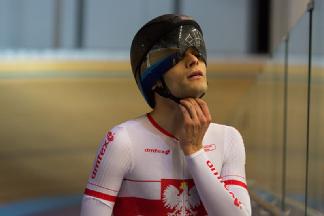WMG News
The next generation of WMG engineers
Congratulations to the 2018 cohort of Graduate Trainee Engineers who have all now successfully completed the Scheme, and secured new positions as Project Engineers at WMG.
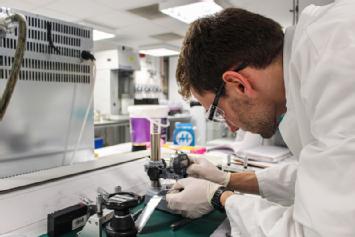 Over the last two years the eight graduates; Harry Chan, Edward Griffin, Katerina Gonos, Jet Feng, Ben Ayre, Adam Szypula, Vidya Narayanan and Puja Unadkat; have been developing their engineering skills by working with academics and industry partners on either autonomous vehicles or energy innovation research.
Over the last two years the eight graduates; Harry Chan, Edward Griffin, Katerina Gonos, Jet Feng, Ben Ayre, Adam Szypula, Vidya Narayanan and Puja Unadkat; have been developing their engineering skills by working with academics and industry partners on either autonomous vehicles or energy innovation research.
Several of the graduates have also had their work published in leading academic journals and shared their expertise at key industry events.
In addition all eight have also supported WMG’s Outreach programme by taking part in workshops, demonstrations and talks with local school children including at the University’s Family Day events.
WMG’s Graduate Scheme Manager, Louise Oddy explains: “The recent success of our graduates is a true testament to their consistent hard work, determination and professionalism. They have made a lasting impact across several areas of WMG and will continue to do this within their roles as Project Engineers. Growing our own talent is integral to the future success of WMG and I could not be prouder of all of the Graduate Engineers. Thank you to those across the department that continue to support the scheme and make our programme so unique.”
 Project Engineer, Ed Griffin adds: “WMG is an exceptional organisation where the graduate scheme promotes excellent tailored development in each graduate’s individual technical field. Our exposure to a range of cutting-edge automotive research, combined with various project management opportunities, is now invaluable in our Project Engineer roles.”
Project Engineer, Ed Griffin adds: “WMG is an exceptional organisation where the graduate scheme promotes excellent tailored development in each graduate’s individual technical field. Our exposure to a range of cutting-edge automotive research, combined with various project management opportunities, is now invaluable in our Project Engineer roles.”
Find out more about the WMG Graduate Scheme here.
Warwick Racing team develop second electric race car during lockdown
Warwick Racing is a team of 30 dedicated members all working towards getting a single-seater electric race car designed, manufactured and tested in the space of a year. The team consists of students from multiple departments including the School of Engineering, Warwick Business School and the Department of Computer Science, with the help and facilities of WMG.
The team usually spend their summer in the workshop building a race car. The Covid-19 lockdown hasn’t stopped them from designing and virtually validating their second electric competition car, WRe2.
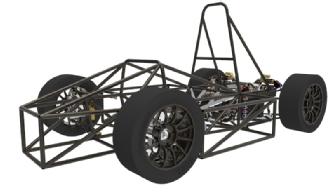 The design of WRe2 was started by the 4th year team in October last year who completed development of the powertrain, suspension and chassis. Over the last few months this work has ramped up, continually improving the designs.
The design of WRe2 was started by the 4th year team in October last year who completed development of the powertrain, suspension and chassis. Over the last few months this work has ramped up, continually improving the designs.
As a team first, the bespoke powertrain has not one, but two rear electric motors. The idea of two motors is to allow better control when deploying power in race conditions.
The Control Systems team have been working on developing a traction control system, employing the E400 Automotive Motor Controller under guidance kindly provided by Embed. The framework was developed in Simulink with future expansion kept in mind. Specifics of the vehicle powertrain, suspension configurations and tyre models were considered to achieve the fastest acceleration possible whilst effectively managing rear tyre slip.
Meanwhile, the workshop has very recently opened so students have started preparing the car that they’ll eventually see doing 0-60mph in 4.5 seconds. This has a power to weight ratio of around 300hp/tonne comes very close to the ratios seen in Formula E racing!
Rens Bossers, the chief powertrain engineer for the coming year says:
“WRe2 is a level up for Warwick Racing. By learning from issues found during the build of WRe1, our first electric car, the design is very resilient. As reliability is historically a very significant factor, WRe2 puts us in great stead for a very competitive finish at our annual competition, FSUK. The dual motor setup is also a massive step towards the 4-wheel drive powertrain that we aim to achieve in the near future.
“It is great that we have had the support of several major sponsors such as Catapult, Ford and RS Components – their support has got us to where we are and enables us to continually come up with new, innovative designs.”
However the design and validation of the new vehicle isn’t all the team have been up to, they’ve also been able to virtually race their current vehicle, WRe1, in the FSUK 2020 Virtual Challenge.
Sixty-six teams participated in the event, with the Warwick Racing team managing to get into the final for cost, finishing in 5th place. In their business presentation the team finished in 7th place.
As a first for this year, the dynamic events included wheel to wheel sim racing. Despite having little preparation time, the team finished in 10th place overall, with their best performance being 3rd place in an individual race out of 34 competing teams.
Iqra Hamid, Chief Powertrain Engineer for the 2019/20 season who oversaw the development of both vehicles, comments:
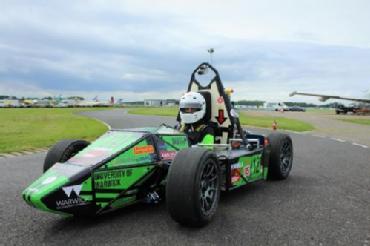 "I've always had a passion for engineering and all things motorsport so being involved with Warwick Racing over the past 4 years has been an amazing experience! The team have come a long way in such a short space of time with the development of WRe1 and now WRe2.
"I've always had a passion for engineering and all things motorsport so being involved with Warwick Racing over the past 4 years has been an amazing experience! The team have come a long way in such a short space of time with the development of WRe1 and now WRe2.
“Whilst we weren't able to showcase our performance live on the track this year, I'm proud of how well the team came together to make the most of the situation during lockdown, achieving some of our best results to date in the virtual Formula Student competition.
“As the team now enters the new season, I'm looking forward to watching the team continue to build upon this success and achieve even better results at FSUK 2021!"
The entire car is built using funds from sponsors – without their generous support the project would not be possible. With thanks to WMG, Catapult HVM, Ford, Embed, Zuken, Vector, Emrax, Demon Tweeks, Loctite, RS, Colt, Igus, Lohmann Technologies, Aquajet, IMI, GRM, ST Motorsport, B-G Racing, Race Parts, AIM, OBP, Powerflex and the many other supporters of the project.
ENDS
10 SEPTEMBER 2020
NOTES TO EDITORS
High-res images available to view at: https://warwick.ac.uk/services/communications/medialibrary/images/september_2020/warwick_racing_render.jpg
Caption: A render of WRe2 spaceframe.
Credit: Warwick Racing, University of Warwick
Caption: Wre1 on track
Credit: Warwick Racing, University of Warwick
Warwick Moto’s electric superbike build racing ahead despite lockdown
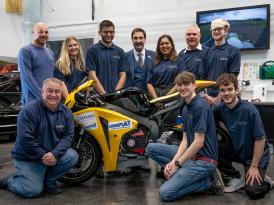 Warwick Moto team, consisting of 25 Warwick students aren’t letting the pandemic get in the way of designing, building and developing the electric superbike, as they’re doing it virtually from home.
Warwick Moto team, consisting of 25 Warwick students aren’t letting the pandemic get in the way of designing, building and developing the electric superbike, as they’re doing it virtually from home.
It was hoped that the Warwick Moto team would see their electric superbike Aurora race this summer with racer Tom Weeden racing it for them. Although plans are on hold due to the current pandemic, students have tried to make the most of their time during lockdown by carrying out virtual meetings to progress on the project as a whole.
Meeting online, the 25 students from a range of Departments including: WMG, School of Engineering, Computer Science, Physics and Maths have redesigned a vital part of the superbike chassis, the subframe.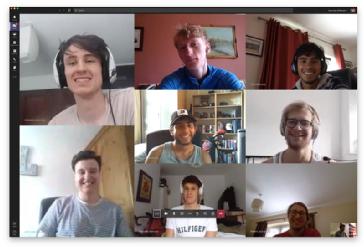
The subframe is an integral part of the motorcycle geometry, therefore, has an impact on handling characteristics of the superbike by defining the seating position of the rider. The subframe for Aurora will also package a critical powertrain component, the inverter for the 3-phase 150 kW (200 bhp) electric motor along with some low voltage components.
The team utilised previously gathered data from the strip, measure and weigh activities performed in November 2019 before lockdown, with the help of the metrology team at WMG. This exercise enabled them to define the necessary constraints for the position of the subframe. They have managed to make it 1.5kg lighter than a stock Honda Fireblade subframe and roughly 300g than a racing one. It’s made using carbon fibre and aluminium parts as opposed to just aluminium, reducing weight and increasing the overall stiffness.
Nesta Ferguson and Aneesh Jois, two first year School of Engineering students, have led the design and engineering cycle behind the subframe while discussing ideas, constraints and risks with the rest of the team through online meetings.
Aman Surana, a School of Engineering student and the Chief Engineer for the Warwick Moto team comments:
“We wanted to make the most out of lockdown and try to use this setback as an opportunity to enhance the bike instead. The team’s design intent was to create something simple, easy to assemble and the ability to be built off-site.
“The current global situation demands for concepts that can be built while maintaining social distancing, this new design helps us achieve that as it can be put together by a single person. As a result, we can utilise workshop time for other critical activities.
“We believe this concept could be used by other racing enthusiasts, as it’s made using stock carbon fibre tubes cut to size and bonded to aluminium joining nodes, where the contact surfaces have been sanded to increase bond strength and area. Moreover, it has the potential to be used on other parts of the superbike at a much lower cost than traditional composite only components.”
Having spent the last 3 months to continuously come up with various load-cases to simulate and optimise the subframe structure, the team have used techniques such as shape optimisation to minimise the amount of material used.
The team are still hoping to be able to test the bike in winter, as a competition between University teams is still hoping to take place early next year, however their long-term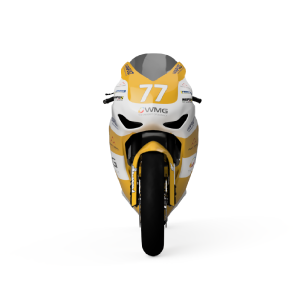 objective is to compete with a podium qualifying time at the Isle of Man TT 2022.
objective is to compete with a podium qualifying time at the Isle of Man TT 2022.
Rock West Composites are donating the raw material required for this concept along with advice to improve things like bond strength from their years of experience with composites. Xometry Europe have supported the team by providing on-demand manufacturing services that have enabled the manufacture of the joining nodes. The team will be able to assemble this concept off-site with the support of Rock West Composites and Xometry Europe.
Significant support from industrial partners such as High Value Manufacturing (HVM) Catapult team at WMG, MUPO Race Suspension, Michelin Tyre PLC, DYMAG Performance Wheels, MIVOLT, Demon Tweeks, SITRAmoto and Rajputana Custom Motorcycles have immensely helped the team, for which they would like to thank them all for.
To support the team making their first electric bike, you can sponsor them or donate to them here: https://www.justgiving.com/crowdfunding/warwickmoto
Follow their journey:
Instagram: https://www.instagram.com/warwick.moto/
Facebook: https://www.facebook.com/warwickmotoracing/
LinkedIn: https://www.linkedin.com/company/warwick-moto/
ENDS
5 AUGUST 2020
NOTES TO EDITORS
Video of the team during lockdown available to view at: https://www.youtube.com/watch?v=BLyj7fzbIw0&feature=youtu.be
FOR FURTHER INFORMATION PLEASE CONTACT:
Alice Scott
Media Relations Manager – Science
University of Warwick
Tel: +44 (0) 7920531221
E-mail: alice.j.scott@warwick.ac.uk
It’s electrifying!
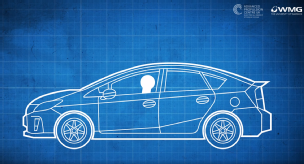 WMG Centre High Value Manufacturing Catapult, with support from Advanced Propulsion Centre (APC) Electrical Energy Storage Spoke, has created a series of short educational videos to help explain the process of transport electrification.
WMG Centre High Value Manufacturing Catapult, with support from Advanced Propulsion Centre (APC) Electrical Energy Storage Spoke, has created a series of short educational videos to help explain the process of transport electrification.
There are a total of three episodes featuring WMG’s Electric Vehicle experts Professor David Greenwood, Research Fellow Faduma Maddar, and Dr Mel Loveridge.
In each episode, the experts explain more about the research carried out at WMG’s Energy Innovation Centre and address the key issues surrounding an electric future.
The videos will now be shared with policy makers, and schools across Coventry and Warwickshire to help support STEM learning.
The three episodes can be found in WMG’s Electric Vehicle playlist here.
Inspiring the next generation of scientists, mathematicians and engineers
WMG’s Outreach team has completed another successful series of Royal Institution Masterclasses for school children across Coventry.
The classes aim to open the eyes of young people to the excitement of engineering, and in turn, inspire the next generation of scientists, mathematicians and engineers.
Local schools were invited to nominate two year nine students to take part, with a total of 24 students participating in the sessions overall.
The Masterclasses were held on Saturday mornings in the form of interactive workshop sessions focusing on a different aspect of engineering. The Series was delivered by staff and students from WMG, with several of this year’s classes led by researchers working on key WMG HVM Catapult projects.
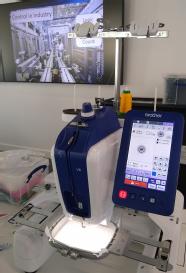 Professor Margaret Low, Director of Outreach and Widening Participation at WMG explained: “Sadly, due to the Covid-19 pandemic, the final masterclass focusing on software and control could not be held as an interactive session on campus.
Professor Margaret Low, Director of Outreach and Widening Participation at WMG explained: “Sadly, due to the Covid-19 pandemic, the final masterclass focusing on software and control could not be held as an interactive session on campus.
“Instead myself and Helen Luckhurst, Project Officer at WMG HVM Catapult, held the final session virtually across two evenings.”
Professor Low added: “The virtual classes were a complete first for the Outreach team, a strange but still successful end to the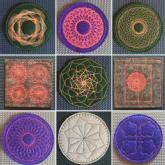 Masterclasses. We presented a series of video tutorials and the students then used their programming and pattern skills to create an embroidered pattern design for a coaster. There were some really great designs.”
Masterclasses. We presented a series of video tutorials and the students then used their programming and pattern skills to create an embroidered pattern design for a coaster. There were some really great designs.”
Find out more about the 2020 RI Masterclasses here.
Teach your kids STEM at home – tips from real engineers
 Now that schools across the UK are closed due to Covid-19, the challenge is on for parents to keep their children educated. Or failing that – just keep them occupied.
Now that schools across the UK are closed due to Covid-19, the challenge is on for parents to keep their children educated. Or failing that – just keep them occupied.
The outreach team from WMG, University of Warwick, want to encourage children and their parents and carers to use this time to explore some of the fun, creative STEM learning opportunities which are available online. With support from WMG centre HVM Catapult, the outreach team at WMG has produced a number of online activities for children of all ages to get involved and learn something new.
Professor Margaret Low, Director of Outreach and Widening Participation for WMG, explains:
"With schools closing it’s a real opportunity to engage parents and carers with online teaching resources, to ensure children are getting an education at home during these uncertain times.”
“We hope these resources, which are suitable for young people of all ages, will inspire children to take up careers in STEM. Many children may think of engineering as physically making things, but don't realise the maths or computer design skills required, which could open up a great career for them in the future.”
 The first resource suggested by WMG outreach team is Turtlestitch, which is great for children in school years 5 to 9. Turtlestitch is a free website on which users can write a program to control a digital embroidery machine. It is used by WMG for outreach activities, as a means of raising awareness of the breadth of engineering. Young people really enjoy using Turtlestitch for pattern design, with or without access to a digital embroidery machine, which makes it ideal for learning at home while schools are closed.
The first resource suggested by WMG outreach team is Turtlestitch, which is great for children in school years 5 to 9. Turtlestitch is a free website on which users can write a program to control a digital embroidery machine. It is used by WMG for outreach activities, as a means of raising awareness of the breadth of engineering. Young people really enjoy using Turtlestitch for pattern design, with or without access to a digital embroidery machine, which makes it ideal for learning at home while schools are closed.
Helen Luckhurst, a Project Officer at WMG, University of Warwick comments: “Turtlestitch is great for children learning at home because it gives them a fun context for applying maths skills. It is interactive and engaging as children discover the patterns they can make using maths.”
“We have created a number of resource cards and video tutorials to support its use, so I hope that parents and carers will encourage their children to use this as a different way of learning.”
Find WMG video tutorials, how-to cards and maths tasks to guide users through Turtlestitch here. Explore the learning materials on basic programming skills, year 5 and 6 maths, craft projects and further mathematical investigations.
Another fun activity for both primary and secondary school children is Tinkercad, a colourful, easy to use computer-aided design software, which is free to use in the web browser and suitable for children from around 8 years of age. Teachers, kids, hobbyists, and designers use it to imagine, design, and make anything. It is used by WMG outreach as part of the Warwick Bright Stars programme in primary schools. Parents can find video tutorials and ideas for several projects here, including keyrings, money pots and lolly drip trays.
Diane Burton, a Project Officer at WMG, University of Warwick explains: "These Tinkercad projects engage children in the design process, and get them using measurements and maths as an essential part of their design work.”
 Autodesk Fusion 360 is a powerful, professional CAD package. It is used in secondary schools and is suitable for ages 14+, and a free download is available to students, educators and enthusiasts. WMG video and written tutorials are available here, where you will find projects including design of assistive technology.
Autodesk Fusion 360 is a powerful, professional CAD package. It is used in secondary schools and is suitable for ages 14+, and a free download is available to students, educators and enthusiasts. WMG video and written tutorials are available here, where you will find projects including design of assistive technology.
Parents may also want to do some experiments at home with their children, which are fun and educational for any age.
WMG staff have made videos available of demonstrating experiments to do at home, using household items and toys you might already have. It is advisable that children are supervised during these experiments.
Watch Graduate Trainee Engineers Lauren, Jacob, Josh and Lucas demonstrating STEM experiments, and follow a guide to building a pulley from a toy construction set. There are many more experiments to come, telling the engineering story behind household objects.
Dr Phil Jemmett, a Project Officer at WMG, University of Warwick comments: “Every product in your house has been made by engineers and shaped by scientists. We want to tell the story behind those items and show you experiments that you can do with everyday stuff. Now that we are all staying in our homes, we just have to find a way to do STEM with what we’ve got!”
Parental supervision is advised when accessing external websites.
WMG pledges support to STEM for Britain
WMG was delighted to support STEM for Britain 2020 earlier this week for the fourth consecutive year.
STEM for Britain is a poster competition with five categories including Biological and Biomedical Sciences, Chemistry, Engineering, Mathematical Sciences and Physics. It took place at the Houses of Parliament bringing together early career researchers and MPs from across the UK.
This prestigious annual event is an important date in the parliamentary calendar because it gives MPs an opportunity to speak directly to some of the UK’s brightest young researchers.
Professor David Mullins, WMG Head of Department (interim) said: “This is the only event in the year that brings together really creative, really intelligent and passionate, young PhD and early career research students.
“We are delighted and honoured that WMG was able to sponsor the engineering element along with the Royal Academy of Engineering.”
He added: “For MPs it’s a really inspiring event. They get the chance to see the work coming out and how issues including climate change and healthy aging are being addressed. These young people are our future.”
Stephen Metcalfe MP and Chairman - Parliamentary and Scientific Committee, said: “These early career engineers, mathematicians and scientists are the architects of our future and STEM for BRITAIN is politicians’ best opportunity to meet them and understand their work.”
Greg Clark MP, Chair of Science and Technology Select Committee, explained: “It is a growing field that will have a huge impact on millions of people. STEM research will change the lives of our generation and of generations to come.”
Four University of Warwick students Jake Brooks (School of Engineering), Fabienne Bachtiger (Computational Chemistry), Robert Richardson (School of Chemistry) and Jonathan Harrison (Mathematics Institute) presented posters at the event.
Introducing CAD to Coventry children
The WMG Outreach team, funded by the lmagineering Foundation, has delivered a special CAD and 3D printing programme to more than 200, ten and 11 year olds across Coventry and Warwickshire.
Four University of Warwick undergraduate engineering students delivered the programme, throughout 2019, in a series of workshops designed to raise awareness and knowledge of CAD and 3D printing.
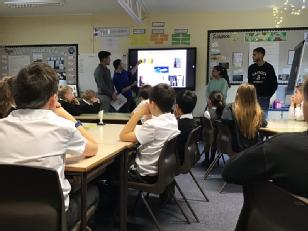 Workshop 1: Introduction to the programme and learning about 3D printing
Workshop 1: Introduction to the programme and learning about 3D printing
In the first session the team explained the role of engineers in the design process. The children were also shown how 3D printers are used to create prototypes.
Ice lollies!
In small groups the children were tasked with designing, (using CAD), and creating, (using 3D printing), an ice-lolly drip tray. During the design process the Outreach Team explained the importance of taking accurate measurements to ensure that the designs would actually work.
The challenge
Using a hairdryer (to create the feel of a warm summer’s day!) the children were presented with the problem of dripping lollies! The challenge to design a suitable drip tray was then set.
The children used life-sized 3D printed ice lollies on sticks to take key measurements needed for their drip tray designs. The pupils discussed and sketched design ideas including adding key measurements. These measurement and design sheets were then used in the next two workshops to help develop their CAD designs.
Workshop 2: Using Tinkercad to draw lolly drip tray designs in CAD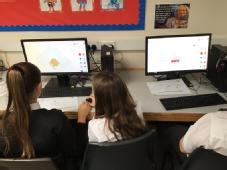
A video tutorial was used to show the children how to use Tinkercad. Building on their design work from Workshop One, the children began producing CAD drawings for the drip trays.
Workshop 3: Using scaled digital lolly model to assess and improve designs
Pupils put the finishing touches to their designs and used the scaled digital lolly models to visualise and assess their designs, considering any design modifications that were needed to ensure the drip tray was effective. The children were encouraged to continue this process until they were confident the design would work.
Towards the end of the workshop, the class shared their finished designs. The class then voted for their favourite two, these were then 3D printed and returned to the school as a momentum.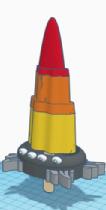
Diane Burton, Project Officer STEM Outreach explained: “The school pupils had fun learning key design principles, and they have successfully produced products that are both functional and creative.”
You can find out more about all of WMG’s Outreach activities here.
WMG helps Senior Teaching Fellow break cycling world record
In a bid to fulfil a two-year ambition, Senior Teaching Fellow Piotr Klin teamed up with WMG to prepare the race package for his UCI World Masters Hour record attempt on July 21st.
Scooping the cycling accolade at his native Polish velodrome of Arena Pruszkow, Piotr’s distance of 49.649km beat the previous record for the 30-34 age group of 48.234km set by Britain’s Ryan Davies.
The World Masters Hour concept requires racers to ride around a velodrome and cover the furthest distance within 60 minutes. Having narrowly missed out on breaking the Polish hour record in August last year, Piotr collaborated with WMG at the University of Warwick to make technical advancements to his bike, utilising the state-of-the-art facilities at WMG.
Piotr reviewed the 3D printed parts within his bike to minimise the drag on the track, and commenting on his successes, the Coventry resident originally from Lublin in Poland said:
“This is a great achievement for me, and it feels extra special to do this in my home country. The extra time that I have spent training in the velodrome has paid off. WMG manufactured parts were custom made to best fit my body, using 3D scanning and printing techniques to deliver a custom cockpit fit, providing comfort during the longest hour in cycling.
“By leveraging the world-leading expertise and facilities through my collaboration with WMG, I’ve been able to bring the best race package I’ve had to-date and deliver this world record performance.
“I’m excited for new challenges following this milestone and look forward to collaborating with WMG further to post even faster times.”
By breaking the world record, Piotr added a further feather to his cap, which already includes a well decorated repertoire of accolades, including merits for being a three-time Polish Masters National Time Trial champion and his crown of Amateur Sportsman of the Year from the 2018 Coventry and Warwickshire Sports Awards.
Building on his successes, Piotr now hopes to go one better than his second place in 2017 at the UCI Gran Fondo World Championships Time Trial in Poznan in August.
WMG supports Kenilworth school children in national STEM competition
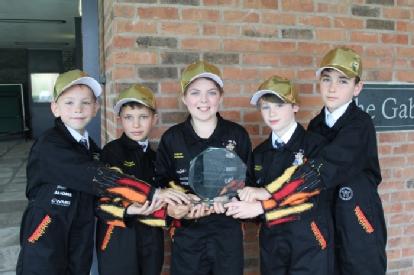 Staff from WMG have been supporting the Firecrackers, a team of five Year 4 children from Crackley Hall School in Kenilworth, at the Jaguar Primary School Challenge.
Staff from WMG have been supporting the Firecrackers, a team of five Year 4 children from Crackley Hall School in Kenilworth, at the Jaguar Primary School Challenge.
The Jaguar Primary School Challenge is a STEM competition, with the aim being to inspire children to consider engineering as a career.
Professor Alan Chalmers, Dr Ali Asadipour and Maria Vasquez Caropres supported the Firecrackers throughout the project to research, design, manufacture, test, promote and race the fastest car possible using standard chassis and engine housing nets to create a car body made only from card.
The team’s achievements were first put to the test at the Regional Finals at Princethorpe College in May. The standard was incredibly high, with the Firecrackers taking second place overall and qualifying for the National Finals. The team also won the awards for Best Engineered Car, Best Portfolio and Best Pit Display.
The WMG team then set about helping the Firecrackers to prepare and modify their car for the National Finals which was held in June at the British Motor Museum, Gaydon.
Each car was judged by a panel of experts from Jaguar Land Rover with the design, portfolio and pit display all examined in detail. The children were also required to give a presentation, before the car was plugged into a compressed air canister and raced down a special track.
Although not the fastest on the day, the judges were highly impressed by the final design, and the clear and articulate manner in which the children were able to present their design decisions. The Firecrackers were delighted to be awarded the “Best Engineered Car” title ahead of 38 other teams from across the country. 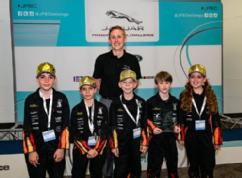
Professor Alan Chalmers said: “The collaboration has been rewarding for all involved. The children have on many occasions expressed their enthusiasm for engineering. We’re looking forward to supporting next year’s team, and perhaps even winning the title of Fastest Car!”
Find out more about the Jaguar Primary School Challenge here.



